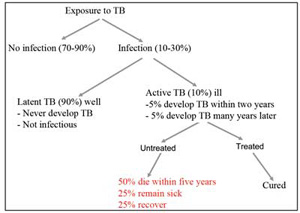13.4.2 Natural history of tuberculosis
Look at Figure 13.3 which illustrates the different outcomes of a person exposed to TB infection. You can see that exposure to TB does not lead to infection of the contact in 70–90% of cases. For those 10–30% of individuals that do become infected with M. tuberculosis, in about 90% of them, the body’s immunity either kills the bacteria, or perhaps more often, keeps them suppressed (inactive), causing LTBI. (In HIV infected persons, TB infection progresses to disease more rapidly due to the weakening of their immunity.) In healthy individuals, only about 10% of infected persons develop active disease and become ill.
Without treatment, 50% of patients with pulmonary TB will die within five years, but most deaths are within two years; 25% will remain sick with chronic, infectious TB which can be spread to the community. Another 25% will spontaneously recover and be healthy, due to their strong immune defences, but they could become sick again at any time if the TB bacteria are latent.
13.4.1 Who is at risk from tuberculosis?

